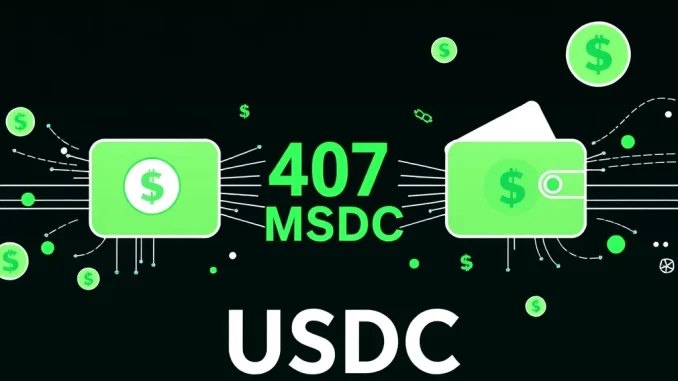
Get ready for some serious crypto movement! A truly eye-popping event just hit the blockchain, and it involves a large USDC transfer. We’re talking about hundreds of millions of dollars shifting hands. This kind of activity always sparks curiosity in the crypto community, especially when the destination is shrouded in mystery.
What the Whale Alert Report Revealed
The popular blockchain tracking service, Whale Alert, recently flagged a significant transaction that caught everyone’s attention. Their report indicated that precisely 407,000,000 USDC was transferred from a wallet associated with Ceffu. The destination? An address currently labeled as an unknown crypto wallet. At the time of the transfer, this single USDC transaction was valued at approximately $407 million, reflecting the stable nature of USDC’s peg to the US dollar.
Here are the key details of this massive movement:
- Amount: 407,000,000 USDC
- Source: Ceffu
- Destination: Unknown wallet
- Value: Approximately $407 million
- Reported by: Whale Alert
Understanding the Key Players: Ceffu and USDC
To fully grasp the potential implications of this movement, it helps to know who is involved:
Ceffu: Formerly known as Binance Custody, Ceffu is an institutional-grade digital asset custody service provider. It’s designed for large players like exchanges, funds, and financial institutions. A transfer originating from Ceffu often suggests activity by a significant entity, rather than an individual retail investor.
USDC: USD Coin (USDC) is the second-largest stablecoin by market capitalization. Issued by Circle and Coinbase, it’s designed to maintain a stable value, pegged 1:1 with the US dollar. Stablecoins like USDC are frequently used by traders and institutions to move large amounts of value quickly and cheaply across exchanges or between wallets without dealing with the price volatility of cryptocurrencies like Bitcoin or Ethereum. This makes a stablecoin transfer of this size particularly noteworthy.
Why Track a Massive Stablecoin Transfer?
Tracking large cryptocurrency movements, especially stablecoins, is crucial for several reasons:
- Indicative of Whale Activity: Large transfers often signal the actions of ‘whales’ – entities or individuals holding substantial amounts of crypto. Monitoring these crypto whale movements can provide insights into potential future market activity.
- Market Positioning: While a stablecoin transfer itself doesn’t directly impact market prices, large movements to or from exchanges or specific wallets can suggest intentions to buy or sell other assets.
- Institutional Activity: Transfers from platforms like Ceffu are strong indicators of institutional participation in the market.
Exploring the “Unknown Crypto Wallet”
The fact that the destination is an unknown crypto wallet adds a layer of intrigue. It’s important to understand what ‘unknown’ means in this context:
It doesn’t automatically imply anything illicit. An ‘unknown’ wallet simply means the address hasn’t been publicly identified or linked to a specific entity (like an exchange, known fund, or service) by tracking services like Whale Alert. It could belong to:
- A private institutional cold storage wallet.
- An over-the-counter (OTC) trading desk.
- A different exchange’s hot or cold wallet not yet labeled.
- A large private investor or fund.
The challenge is that without further information, the exact purpose of this large USDC transfer remains speculative.
Potential Scenarios Behind This Large USDC Transaction
Given the source (Ceffu) and the scale, several plausible scenarios could explain this significant USDC transaction:
1. Institutional OTC Trade: A large over-the-counter (OTC) trade might have been executed. Institutions often use OTC desks to buy or sell large volumes without impacting public exchange order books. The USDC could be moving to settle a large purchase of another asset or be the proceeds from a large sale.
2. Exchange Rebalancing or Internal Transfer: While originating from Ceffu, the funds could ultimately belong to an exchange that uses Ceffu for custody. This could be an internal transfer between different types of wallets (e.g., cold storage to hot wallet) or rebalancing across different custody solutions.
3. Migration to a New Custodian/Wallet: The entity holding the funds might be moving them to a new custody provider or consolidating assets into a new wallet structure.
4. Preparing for Deployment: A fund or institution might be moving stablecoins to a more active wallet in preparation for deploying capital into the market, perhaps to buy other cryptocurrencies.
Each of these scenarios highlights the potential for this movement to be a precursor to further market activity by a significant crypto whale.
What Does This Mean for the Market?
A stablecoin transfer of this magnitude doesn’t directly influence asset prices, but it’s like seeing a giant ship change course – it suggests future movement. When large amounts of stablecoins move, market observers watch closely to see if they land on exchanges (potentially signaling intent to buy assets) or move off exchanges (potentially signaling intent to hold or engage in OTC deals).
This particular transfer moving *from* Ceffu *to* an unknown wallet doesn’t definitively signal an imminent exchange deposit. It could be moving into private cold storage or towards an OTC counterparty. The next step for those tracking this is to monitor the destination unknown crypto wallet for subsequent movements.
Actionable Insights for Tracking Crypto Whales
While most of us aren’t moving $407 million, tracking crypto whale activity offers valuable insights:
- Use Tracking Services: Follow Whale Alert and similar services that report large transactions.
- Identify Sources/Destinations: Pay attention to where funds are coming from (exchanges, custody providers, known entities) and where they are going.
- Look for Follow-Up Moves: A single large transfer is a data point, but subsequent movements from the destination wallet are often more telling about intent. Does the USDC move to an exchange? Does it get swapped for other assets on-chain?
- Context is Key: Combine whale tracking data with other market analysis, news, and on-chain metrics.
Challenges in Identifying Unknown Wallets
Despite the transparency of blockchain, identifying the owner of an unknown crypto wallet can be challenging due to:
- Privacy: Blockchain addresses are pseudonymous. Unless an owner publicly links an address to their identity or uses a service that does, it remains ‘unknown’.
- Complexity: Large entities often use multiple addresses for security and operational reasons, making it hard to consolidate and identify all their holdings or activities.
- Off-Chain Deals: Large OTC deals are agreed upon off-chain, and the blockchain transfer is merely the settlement mechanism, which doesn’t reveal the counterparty’s identity.
Conclusion
The reported large USDC transfer of $407 million from Ceffu to an unknown crypto wallet is a prime example of the significant capital movements occurring in the digital asset space. While the exact purpose of this massive USDC transaction remains speculative, it strongly indicates activity from a major institutional player or crypto whale. Monitoring such substantial stablecoin transfers provides valuable, albeit sometimes ambiguous, clues about potential shifts in market positioning or strategy by the biggest participants. It underscores the importance of on-chain analysis in attempting to decipher the opaque world of institutional crypto flows.



